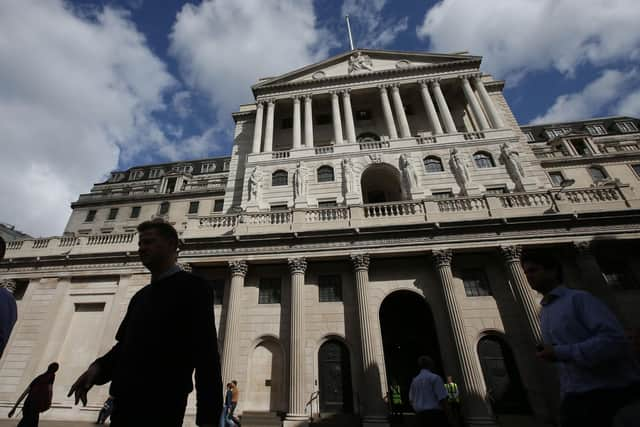BoE expected to hike interest rates at 'crucial' meeting this week
Economists are pencilling in an increase of 50 basis points, or 0.5 of a percentage point, which would take the official bank borrowing rate to 2.25 per cent, though members of the central bank’s monetary policy committee (MPC) face a tricky balancing act.
Much of the inflationary pressure of late has been caused by soaring fuel and energy costs. However, the oil price has recently eased back, leading to a fall at the pumps, and a proposed government cap on domestic energy bills is likely to take some of the heat out of official inflation data.
Advertisement
Hide AdAdvertisement
Hide AdThe MPC pushed its regular rate-setting meeting back by a week to this coming Thursday as a result of the Queen’s death.
ING developed markets economist James Smith said: “[This week’s] Bank of England meeting is crucial. It will tell us not only how worried policymakers are about the slide in sterling and other UK markets, but also how the government’s decision to cap household/business energy prices will translate into monetary policy.
“We narrowly favour a 50 [basis points] hike on Thursday, taking the bank rate to 2.25 per cent, although 75 [basis points] is clearly on the table and we would expect at least a couple of policymakers to vote for it.
“It's even possible we get a rare three-way vote – the first since 2008 – if dovish committee member Silvana Tenreyro votes for a 25bp hike as she did in August. If our call is correct, then we expect another 50bp move in November and at least another 25bp in December. That would take the bank rate to the 3 per cent area.”


Analysts at investment platform AJ Bell noted: “The Old Lady of Threadneedle Street pushed through her first interest rate increase since summer 2018 last December and after a sequence of six hikes in total, the base rate reached 1.75 per cent, compared to its starting point and historic low of 0.1 per cent.
“Markets’ expectations are swinging around wildly, but they are currently pricing in a 35 per cent chance of a half-point increase and a 65 per cent chance of a three-quarter point rise, to 2.25 per cent or 2.5 per cent respectively.”
Fears
On Friday, the pound touched new 37-year lows against the dollar amid concerns over the strength of the UK economy.
A weak pound means people travelling overseas will find their spending money will not stretch as far and the cost of imports rises. However, it can provide a lift to firms exporting goods and services.
Advertisement
Hide AdAdvertisement
Hide AdIt comes at a time when the rate of UK consumer price inflation is running at a near 40-year high, despite slipping to an annual rate of 9.9 per cent in August from July’s 10.1 per cent.
Walid Koudmani, chief market analyst at financial brokerage XTB, said: “The Bank of England has a tough job ahead of it as it must strike the balance between managing inflation, supporting the currency while simultaneously not negatively affecting the overall economy further.”
Comments
Want to join the conversation? Please or to comment on this article.
